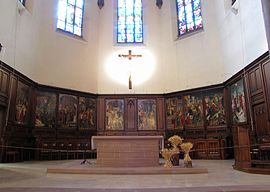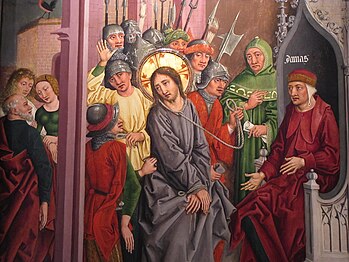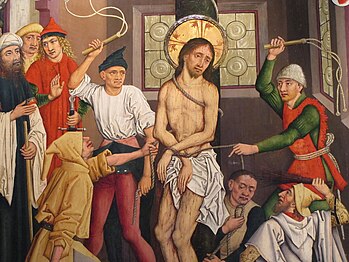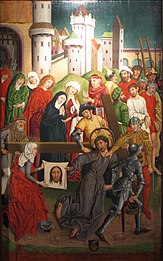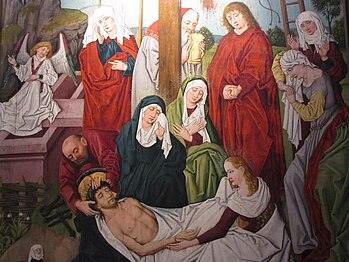
A crucifix is a cross with an image of Jesus on it, as distinct from a bare cross. The representation of Jesus himself on the cross is referred to in English as the corpus. The crucifix emphasizes Jesus' sacrifice, including his death by crucifixion, which Christians believe brought about the redemption of mankind. Most crucifixes portray Jesus on a Latin cross, rather than a Tau cross or a Coptic cross.

The term Poor Man's Bible has come into use in the modern era to describe works of art within churches and cathedrals which either individually or collectively have been created to illustrate the teachings of the Bible for a largely illiterate population. These artworks may take the form of carvings, paintings, mosaics or stained-glass windows. In some churches a single artwork, such as a stained-glass window, has the role of Poor Man's Bible, while in others, the entire church is decorated with a complex biblical narrative that unites in a single scheme.

The San Damiano Cross is the large Romanesque rood cross before which St. Francis of Assisi was praying when he is said to have received the commission from the Lord to rebuild the Church. It now hangs in the Basilica of Saint Clare in Assisi, Italy, with a replica in its original position in the church of San Damiano nearby. Franciscans cherish this cross as the symbol of their mission from God.

The Hours of Jeanne d'Evreux is an illuminated book of hours in the Gothic style. According to the usual account, it was created between 1324 and 1328 by Jean Pucelle for Jeanne d'Evreux, the third wife of Charles IV of France. It was sold in 1954 to the Metropolitan Museum of Art in New York where it is now part of the collection held at The Cloisters, and usually on display.

Lampaul-Guimiliau is a commune in the Finistère department and administrative region of Brittany in north-western France. It is noted for its parish close.
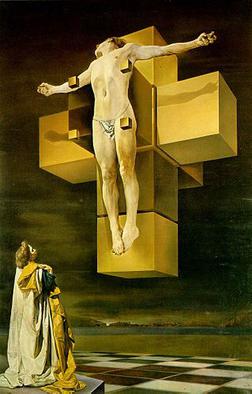
Crucifixion (Corpus Hypercubus) is a 1954 oil-on-canvas painting by Salvador Dalí. A nontraditional, surrealist portrayal of the Crucifixion, it depicts Christ on a polyhedron net of a tesseract (hypercube). It is one of his best-known paintings from the later period of his career.
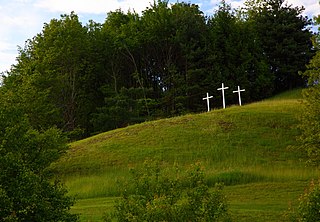
A calvary is a type of monumental public Christian cross, sometimes encased in an open shrine. Usually a calvary has three crosses, that of Jesus Christ and those of impenitent thief and penitent thief.

The Sainte-Madeleine Church is a Catholic church in Strasbourg, France, which was built in Gothic style in the late 15th century, but largely rebuilt in a style close to Jugendstil after a devastating fire in 1904. Destroyed again during World War II, the church was re-constructed in its modern form.

The Batlló Majesty is a large 12th-century Romanesque wooden crucifix, now in the National Art Museum of Catalonia in Barcelona, Spain. It is one of the most elaborate examples in Catalonia of an image of Christ on the Cross, symbolizing his triumph over death.

Crucifixions and crucifixes have appeared in the arts and popular culture from before the era of the pagan Roman Empire. The crucifixion of Jesus has been depicted in a wide range of religious art since the 4th century CE, frequently including the appearance of mournful onlookers such as the Virgin Mary, Pontius Pilate, and angels, as well as antisemitic depictions portraying Jews as responsible for Christ's death. In more modern times, crucifixion has appeared in film and television as well as in fine art, and depictions of other historical crucifixions have appeared as well as the crucifixion of Christ. Modern art and culture have also seen the rise of images of crucifixion being used to make statements unconnected with Christian iconography, or even just used for shock value.

The Church of Old Saint Peters is a by simultaneum Catholic and Lutheran church building in Strasbourg, Alsace is first mentioned in 1130.
The Master of the Drapery Studies, also known as Master of the Coburg Roundels is the notname given to the "very productive" and "multifaceted" late 15th-century author of some 30 surviving paintings and over 150 surviving drawings. Indeed, according to the J. Paul Getty Museum, up to 180 surviving drawings "have been attributed to this master, comprising one of the most extensive bodies of drawn work of any northern European artist before Albrecht Dürer." Conversely, it has been suggested at least once that both the Master of the Drapery Studies and the Master of the Coburg Roundels may be two separate persons and that their body of work is attributable to a whole circle of artists.

The Master of the Karlsruhe Passion is the notname of a German painter of the late Gothic period active in the Upper Rhine. Very influential on other painters in the region, he may be identified with the Strasbourg painter Hans Hirtz. He is named after his main work, the Karlsruhe Passion, though he may also have been the artist behind the murals in the former Dominican church in Strasbourg, only known through two 17th century copies.

The Buhl Altarpiece is a late 15th-century, Gothic altarpiece of colossal dimensions now kept in the parish church Église Saint-Jean-Baptiste of Buhl in the Haut-Rhin département of France. It was painted by followers of Martin Schongauer, most probably for the convent of the Dominican sisters of Saint Catherine of Colmar, and moved to its present location in the early 19th century. It is classified as a Monument historique by the French Ministry of Culture.

The Crucifix by Cimabue at Arezzo is a large wooden crucifix painted in distemper, with gold leaf, by the Florentine painter and mosaicist Cimabue, dated to c. 1267–71. It is the earliest of two large crucifixes attributed to him. It shows a painted representation of the near dead body of Christ on the cross, with Mary, mother of Jesus and John the Evangelist at either end of the cross beams.

The Strasbourg Crucifixion is a painting in tempera and gold on panel of c. 1315 attributed to Giotto, now in the Musée des Beaux-Arts of Strasbourg, France.

The Berlin Crucifixion is a tempera and gold on panel painting that was created c. 1320 and is attributed to Giotto. It is stored at the Gemäldegalerie in Berlin.
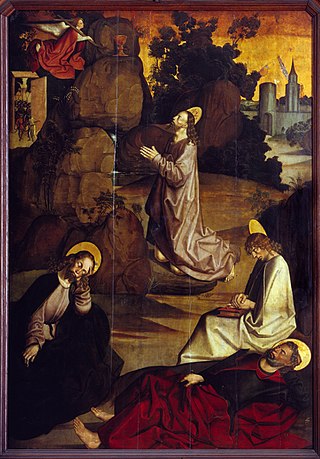
The Litoměřice Altarpiece was a large altar retable, in all likelihood with two pairs of movable wings and two pairs of fixed ones. From these wings, six panels have survived, two of which are painted on both sides. The movable wings on the left-hand side of the altar are presumed lost. The altar wing depicting Christ on the Mount of Olives belongs to the Diocese of Litoměřice, while the other panels are owned by the Regional Museum in Litoměřice. It is the largest surviving set of panel paintings by an anonymous late Gothic and early Renaissance painter called the Master of the Litoměřice Altarpiece. The altarpiece is part of the permanent collection of the North Bohemian Gallery of Fine Art in Litoměřice.

The Pietà from the Dominican Monastery in Cheb is a Gothic wooden pieta sculpture set in Cheb, Czech Republic.
